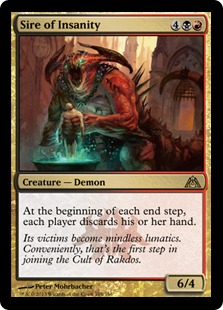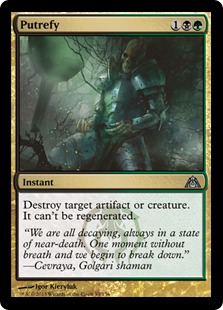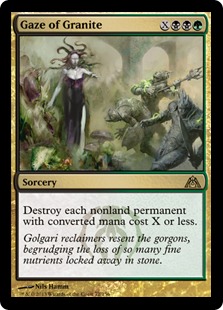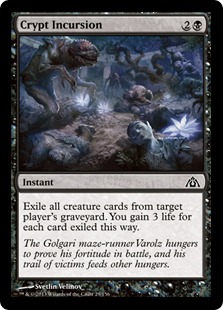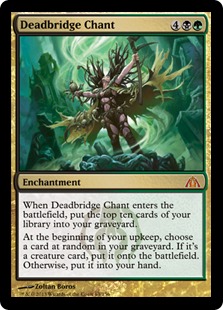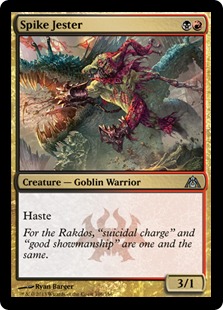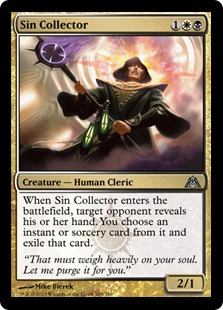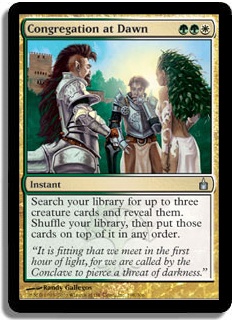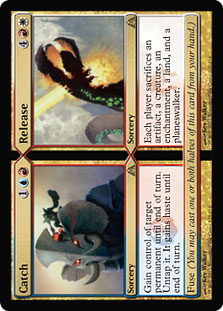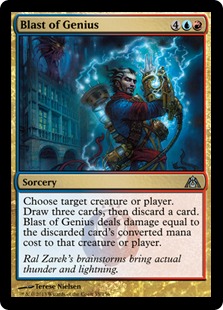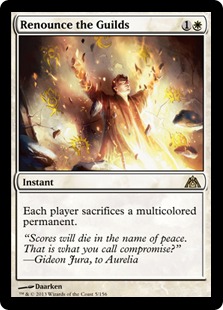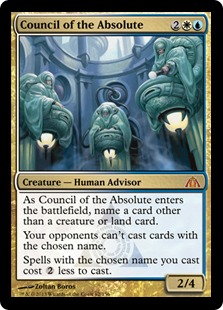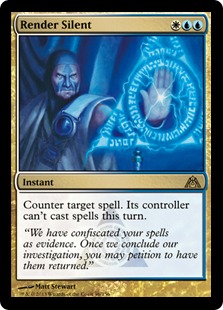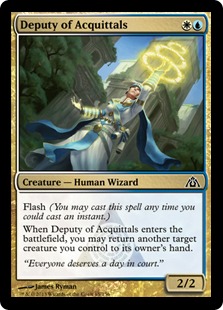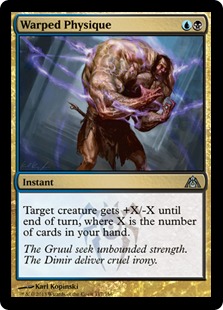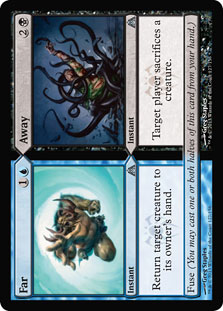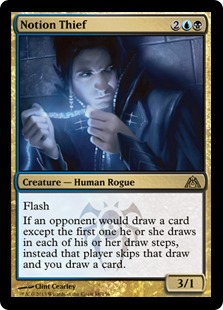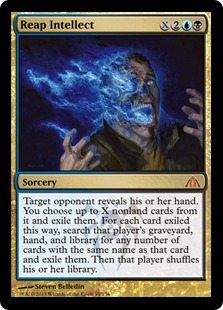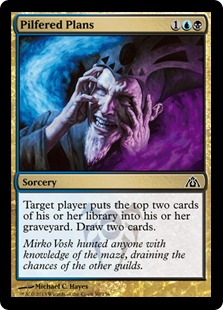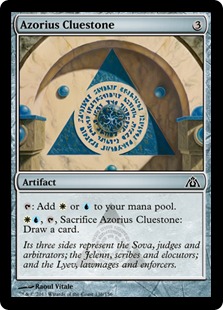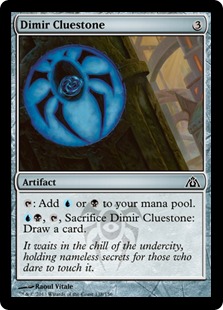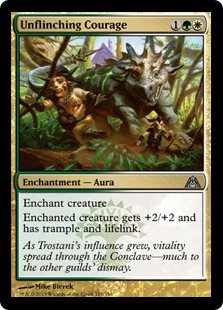Dragon’s Maze is here, and the topic at hand is how best to use the new cards. Monday, we covered updates to most of the non-blue decks in Standard. Today, we hit Jund, The Aristocrats, U/W/R Flash, Esper Control, and Bant Control and then move on to brewing with the new set!
“Jund, good old Jund. Nothing beats Jund…more than 55% of the time.”
The primary question facing Jund in the new format is what to do with Sire of Insanity (if anything). It’s no secret that Sire of Insanity is a powerful weapon (as discussed here), but he’s not the least unwieldy to be sure.
In traditional Jund, Sire of Insanity provides some Rakdos’s Return redundancy, but he’s also competing for those slots to a degree. Sire of Insanity can have a tremendous impact on the board, particularly when paired with Cavern of Souls, but Jund has to play the control deck at times and in those places Sire of Insanity is not always where you want to be.
While I think Sire of Insanity is likely to be a common Jund adoption, I am less optimistic on how big of an impact he will have than many others. It’s a fine card and adjusting to make better use of it could be big, but I kind of imagine the format will be able to adjust against it more than people are giving credit to.
Creatures (15)
Planeswalkers (5)
Lands (25)
Spells (15)

Jund’s other new options are a little less intense.
Putrefy is just an easy Murder upgrade, with the real question being how much of the other removal to convert (if any). Putrefy is great, but with how few artifacts get played in Standard at the moment, it really isn’t that much more than a better Murder. Abrupt Decay’s ability to hit Detention Sphere is a pretty nice advantage.
Gaze of Granite is an expensive sweeper and most likely not what Jund is in the market for. Bonfire of the Damned is just so much better for hitting creatures, and by the time we Gaze big enough to hit noncreature permanents, we could have usually been better off with a Rakdos’s Return or Sire of Insanity. It is worth keeping in mind that if Abrupt Decay gets really good, we may start wanting some amount of Gaze.
Crypt Incursion is a niche sideboard card, but it’s a good one.
Reanimator has always been a challenging matchup for Jund. Ground Seal, while good, doesn’t exactly hit every dimension of graveyard decks. Crypt Incursion isn’t just a surprise graveyard removal spell; it is also a surprise 20-ish extra life. This extra breathing room can go a long way towards giving us the time we need to stabilize under an assault of Restoration Angels, Thragtusks, and Angel of Serenitys. It only buys us a few turns, but Jund has powerful cards like Olivia Voldaren that can completely take over a game if given the time.
One new option that might let us take Jund in a different direction is Deadbridge Chant.
Deadbridge Chant is a sort of Staff of Nin, basically letting us draw an extra card every turn. Instead of being able to ping things, we get to draw an extra quality of spells (despite the self-mill making it more random, cards in your graveyard are generally going to be better and more likely to be nonland). Additionally, every creature we “draw” off the Chant is cast for free, giving us some pretty explosive turns.
Interestingly, Deadbridge Chant is a great complement to Sire of Insanity casting cost aside. Now you are assured business every turn despite playing empty-handed. It does reduce the odds of “going infinite” with Deadbridge Chant, however. It’s probably a very different deck, but if you remove your graveyard from the game and then play something sweet, you can use the Chant to loop it every turn. Makes me want to keep an eye out for Time Warp style cards.
Of course, it can be all too easy to gloss over the meeting point between Gruul and Rakdos, Jund Aggro, but this does not do the archetype justice. The strategy doesn’t have many new options, and those it does have are not definite fits.
Creatures (35)
- 2 Borderland Ranger
- 4 Arbor Elf
- 4 Falkenrath Aristocrat
- 4 Thundermaw Hellkite
- 4 Flinthoof Boar
- 4 Burning-Tree Emissary
- 4 Ghor-Clan Rampager
- 4 Gyre Sage
- 3 Spike Jester
- 2 Zhur-Taa Druid
Lands (23)
Spells (6)

Spike Jester is a fantastic new two-drop, but Jund Aggro isn’t really the best home for it.
To begin with, Spike Jester can’t be played off a turn 2 Burning-Tree Emissary, meaning it doesn’t synergize with Jund Aggro’s best draws. Additionally, this sort of a deck is generally going to have less removal than other possible Spike Jester decks. Spike Jester hits really fast and hard, but he is terribly fragile and brickwalled by everything. Bonfire of the Damned helps, but Rakdos decks with more spot removal are generally going to have an easier time getting him through. Ghor-Clan Rampager becomes even more important if we go the Spike Jester route.
The other new possibility is Zhur-Taa Druid, a card many are writing off as Limited only, but it has chances as a fringe Constructed role-player.
That it is castable off of Burning-Tree Emissary is obviously great, but what makes it better than one might imagine is that you are getting the mana AND the damage every turn. That is not that far off in power compared to a creature that just tapped for two mana! Llanowar Elves is obviously better than Goblin Fireslinger, but Goblin Fireslinger was Constructed playable. Zhur-Taa Druid gives us both of those cards at the same time and helps accelerate us into Falkenrath Aristocrats and Thundermaw Hellkites.
Mana creatures that also add another dimension to your board position can be invaluable, such as Noble Hierarch and Deathrite Shaman. Zhur-Taa Druid costs two rather than one, so it certainly isn’t in their league, but the added reach it offers will likely be enough to prompt at least fringe play.
So why the strange Zhur-Taa Druid / Spike Jester split? When trying new cards, our aim isn’t to have the greatest chances of having an optimal list already; it’s to gain the greatest understanding we can. This way, we gain information about both on their own and together (as some games we’ll draw just one, others both, and some not at all). Once we have a better idea of how they mesh with the other cards in the deck, we can evaluate if we want to go up or down in number.
The other non-blue deck we should cover today is The Aristocrats.
Creatures (20)
Planeswalkers (3)
Lands (24)
Spells (13)

The maindeck suggested above is nothing new and has been played by players like Ben Friedman and Brad Nelson to recent success. It is in the sideboard that The Aristocrats gain a couple options.
Sin Collector is quite solid, giving us a better tools for combating Supreme Verdict decks. That said, it is does have some weaknesses Duress does not, as it can’t hit artifacts, enchantments, or, most notably, planeswalkers. It does, however, give us more incentive to go back towards a Champion of the Parish build.
Possibility Storm[/author]“][author name="Possibility Storm"]Possibility Storm[/author] is a pretty wacky card, but it actually has some pretty potent applications and looks like it could be more of a Constructed player than most of the ridiculous random red rares.
On the surface, this looks like another red enchantment designed to “mix things up,” but consider it against control. It’s unreliable against sweepers since many opponents will have all of their sorceries sweepers, but U/W/R players are at risk of Supreme Verdict turning into a Pillar of Flame.
Where it really shines is against instants and, most importantly, Sphinx’s Revelation. Sphinx’s Revelation is a little special in that it is an X spell, so it doesn’t work at all. If you “possibility” into it, X = zero. This means in addition to any other effect on the game, Possibility Storm[/author]“][author name="Possibility Storm"]Possibility Storm[/author] is sort of a Slaughter Games for Sphinx’s Revelation right out the gate. In fact, it’s even better since some of your other instants will randomly turn into Revelations for zero.
Counterspells don’t work well at all under Possibility Storm[/author]“][author name="Possibility Storm"]Possibility Storm[/author]. In order to actually counter anything, you have to cast your permission spell then randomly flip into another one, which is often going to be 10% or less to actually hit. To make matters worse, some percentage of the time random instants cast to draw cards will turn into Dissipates that can’t be cast. It’s actually going to be the right play for some people to only Think Twice in response to your spells just in case it turns into a Dissipate.
Azorius Charm is another victim of Possibility Storm[/author]“][author name="Possibility Storm"]Possibility Storm[/author]. Drawing a card off of it is fine, but the mode people count on is the ability to put attackers back on top of a library. People won’t be able to count on the Azorius Charms in their hand, and randomly flipping into one won’t always do it since not every spell is cast during the attack phase.
Possibility Storm[/author]“][author name="Possibility Storm"]Possibility Storm[/author] even has random chances of hosing someone that only plays one Detention Sphere or one Jace, Memory Adept. It’s hard to count on, but there is a distinct possibility that this one actually sees play as a sideboard card.
What I wonder is if there is any way to abuse it as a mana cheat. This might be more of a Modern type of thing, but if you can rig the top card of your deck, you should be able to cheat something into play on the cheap. For instance, put an Emrakul on top of your deck and your Memnite will cast it for free (and actually give you the extra turn).
The first thought that comes to mind in this department is to try to set this up with Congregation at Dawn.
Turn 1 – Birds of Paradise.
Turn 2 – Congregation at Dawn.
Turn 3 – Sin Collector (found from Congregation at Dawn).
Turn 4 – Possibility Storm[/author]“][author name="Possibility Storm"]Possibility Storm[/author], Memnite (found from Congregation at Dawn), which then reveals Emrakul, the Aeons Torn.
This is not as nearly a Magical Christmasland scenario as it may seem. After all, the Sin Collector, Memnite, and Emrakul were all found with Congregation at Dawn. You literally just need Possibility Storm[/author]“][author name="Possibility Storm"]Possibility Storm[/author], Congregate at Dawn, and lands to go off on turn 5 and any one cost mana creature to make it turn 4.
It’s not even clear that you couldn’t make some sort of a dedicated Possibility Storm[/author]“][author name="Possibility Storm"]Possibility Storm[/author] combo deck in Standard. I could imagine some strange list featuring half expensive cards and half cheap ones. I have to imagine someone like Michael Flores or Travis Woo will have a list by the end of next week, possibly featuring Unexpected Results.
Ok, enough non-blue decks. Let’s get down to the real business at hand.
Blue decks!
Creatures (12)
Lands (25)
Spells (23)

U/W/R decks are in the interesting position of gaining tons of new options but largely in the sideboard department. Some of these are likely to prove maindeck-worthy once we have a better idea of what the field is looking like, but two of the options in particular are potentially strategy changing.
Aetherling is one of the most exciting cards from Dragon’s Maze and much better than previous Morphling variants. That it is stronger than Morphling isn’t saying much, as these are different times. What’s really appealing about it is that it actually works well with the good control cards and is reliable against the block of the format’s interaction.
Morphling could always be killed by sweepers and was no good in conjunction with Wrath of God. Aetherling is immune to sweepers and actually combines extremely well with Supreme Verdict.
Morphling could beat most enemies in a fight but could be brickwalled at times. Aetherling is completely unblockable and kills very quickly, giving you a very real race plan against difficult problems.
Aetherling is definitely my go-to creature for control decks at this point, and I could see at least one maindeck in basically any blue deck. It’s possible that U/W/R still wants Aurelia, the Warleader for the speed, but I actually prefer Aetherling since it is not that much slower but gives us a very strong game plan against Jund and other control decks. Aetherling is so hard to beat that I imagine we will see more obscure answers popping up like Pithing Needle.
The other new card I think could be really important to U/W/R is Catch // Release.
Catch // Release dramatically changes the ways planeswalkers can be interacted with while having functionality against everyone.
Catch just a brutally effective answer to planeswalker ultimates, letting you steal them the turn before they go off and taking the ultimate for yourself. Zealous Conscripts already did this, but Catch does it cheaper and can be found with cards like Augur of Bolas. Saving a little mana here is particularly important when it comes to Restoration Angel combos.
If you Catch your opponent’s best creature and bash them with it, you can follow up with a Restoration Angel on it and keep it for good! Of course, this trick also works with Cloudshift.
Catch is also very effective against creatures with a self-sacrifice ability, such as Falkenrath Aristocrat (though remember Cartel Aristocrats do not have this same weakness).
Release is a little clunkier but ensures that Catch // Release always has some applications—plus it can be nice to actually be able to interact with artifacts and enchantments (since they are uncommon enough to rarely warrant specific hate for at the moment).
Fusing Catch // Release is obviously sweet but expensive. The combined nine casting cost is far from impossible, but amusingly it can actually be a feature when discarded to Blast of Genius.
Blast of Genius is a tough nut to crack, riding the line between control value card (where it is just a little weaker than we’d want but not much) and combo kill card (where it does something medium unfair but not so unfair that it needs a deck built around it).
The result? A sort of mid-level combo-control card that is best suited for a deck that can make it deal nine or more damage but that can also take advantage of it as a value card (draw three cards and one is a free burn spell).
I wonder about using Blast of Genius in some sort of Boros Reckoner / Blasphemous Act deck. The ability to deal nine out of nowhere (discarding Act or Catch // Release) is particularly valuable in a deck that can deal thirteen out of nowhere (Reckoner + Act) and that gets in some early damage with cheap creatures.
One final combo to consider with Catch // Release is with Renounce the Guilds. While not trivial to pull off, this is a fun way to get a little extra value out of our cards. Renounce the Guilds is a respectable card anyway, particularly against The Aristocrats.
One of the new sideboard options that a lot of people are talking about and that adds a different dimension to Standard is Council of the Absolute. The new Meddling Mage screams “Sphinx’s Revelation” as the ideal card to name, but it can actually have plenty of other applications, sometimes as simple as just combining it with a Cyclonic Rift to thwart a particular permanent.
Remember, you don’t have to name a card you play with, as the cost reduction ability is just gravy. That said, it is also important to remember that you can’t name creatures—an important difference compared to Meddling Mage.
All of this said, in my opinion Council of the Absolute isn’t what you want to be doing in Sphinx’s Revelation mirrors. Tapping out on turn 4 to play this dork leaves yourself so wide open. Even if you don’t get punished by some sort of a planeswalker, the card is quite easy to remove. Even after board, when much of their removal is boarded out, they will have answers to this guy. Besides, there are so many anti Sphinx’s Revelation cards in this set that it’s not like being all-in on it is where you want to be anyway.
U/W/R does pick up a couple very minor options in the form of Render Silent and Turn // Burn.
Render Silent is certainly not always going to be better than Counterflux or Dissipate, but it is another option that could give a couple percentage points in certain places. Where it really excels is against opponents that try to set up key spells with test spells. For instance, if you Render Silent a Jund player’s Liliana of the Veil, you need not fear a Sire of Insanity follow up, at least not this turn. Most of the time, however, this is a rare Cancel.
This ability is solid, but Modern is where it might actually be of slightly more value. Three mana counterspells are hard to justify, but it is an interesting weapon against combo decks.
As for Turn // Burn, this one has generated a surprising amount of hype. On some level, people may be drawn to getting what they normally can’t have (a Murder in U/R) or its ability to fight Thragtusk (since they won’t get the 3/3); however, I think people just love when cards feel like they’re working together. Even though Turn // Burn is a single card that was designed to work with itself, the thought of fusing it is very satisfying because it is so clearly more than the sum of its parts.
I do think it is a little overrated, as two mana for a Shock is pricey and five mana for a Murder even more so. Still, it has applications and is particularly valuable at thwarting death triggers (including Voice of Resurgence, Reveillark, and the aforementioned Thragtusk).
Who wants this the most? Probably some U/R or RUG deck that can’t easily deal with fatties. White and black are generally going to have better answers. If some kind of a U/R/x creature deck emerges, Turn // Burn gains added value from the ability to split it up. It’s a little tricky to pull off, but Izzet Staticaster actually pulls the whole thing together nicely. A single Staticaster and you can get both a Shock and a Murder for five mana by pinging the creature you turn into a 0/1. In a pinch, you can even just use it as a three-cost Murder as long as you are Staticastering (or in combat and feeling lucky).
Izzet Staticaster is one of the cards I keep coming back to as changing in value because of Dragon’s Maze. Its synergy with every element of Turn // Burn is nice, but if we find a place to combine it with Ral Zarek, now we’re really talking!
This combination is outside the scope of traditional U/W/R Flash decks, but it could be the beginning of some new archetype. Ral Zarek is broken down in depth here, and what really makes him shine is when you either really want two Lightning Bolts or you can take real advantage of the +1 ability. Taping down blockers is certainly reasonable (albeit not really what Standard is about at the moment), but being able to untap an Izzet Staticaster can really change a battlefield.
Creatures (13)
Planeswalkers (4)
Lands (22)
Spells (21)

It’s really tough to figure out what all to surround Ral Zarek with to take full advantage of him, but he is a fine card that can be great in decks built to optimize him.
As for U/W/R Flash, the only other really interesting new option is Deputy of Acquittals.
Snapcaster Mage and Augur of Bolas add up to a pretty solid 187 package, so getting to reuse them over and over is pretty hot. Deputy of Acquittals also makes for some really interesting blocking plays. For instance, if your opponent attacks with a Loxodon Smiter, you can block with your Augur or Snapcaster then Deputy it back to your hand. In fact, if you have two Deputies tag-team the Loxodon, you can hold him off indefinitely! While Deputy of Acquittals says “another target creature,” it does not mean that it has to have a different name.
I wonder about what other 187s we might want to use many times. Acidic Slime and Sin Collector are the first two that come to mind, but there are countless options in Standard at the moment. Besides, it doesn’t always have to be a 187 that you bounce. Sometimes, just countering a removal spell is enough. You can even attack with a Geist of Saint Traft then bounce it when they block (netting four points of Angel damage).
A final note on U/W/R Flash, Pillar of Flame’s stock is going up. While it is not a new card, it has new functionality thanks to Voice of Resurgence.
Moving on to Esper Control, we have to shift gears a little and ask ourselves what we imagine our enemies to look like. While U/W/R Flash will be a little more “its own game plan,” Esper is all about positioning itself exactly right. Whenever you can do that, you can beat whatever you want. If you miss, however, you struggle horribly from having a far less good proactive gameplan than most top tier decks.
Creatures (9)
Lands (27)
Spells (24)

Again, I think Aetherling is an important tool for control decks moving forward. It is just so unbelievable against midrange decks that it may push people towards more all-in aggro decks. Esper doesn’t really care what the opponent is playing as long as it knows before the tournament starts. The field has been too diverse lately for Esper to really shine, but if enough people get concentrated into a few decks, Esper will be ready to rear its ugly head.
Look, I love a good control deck as much as the next guy, but the format hits from too many different angles at the moment to really want to play Esper. You can definitely set yourself up to beat Reanimator, but Jund hits from a totally different angle, as does Naya Blitz, as does U/W/R Flash. Even Guillaume Wafo-Tapa set Esper down recently, winning a PTQ with a more controlling build of U/W/R.
Warped Physique is starting to get some buzz, largely because of its ability to reliably kill difficult creatures like Falkenrath Aristocrat for just two mana. That it can randomly be hosed by not enough cards in hand is a strike, but for the most part it is pretty close to Terminate. It is somewhat corner case, but the +X front half will actually steal an occasional win from people that were not expecting your Restoration Angel to deal six or your Augur of Bolas to be able to kill a planeswalker.
It might just be better to play all Warped Physiques, but I kind of like using a couple Far // Aways as well. Hitting hexproof and protect from creatures is a thing, sure, but what I really like is the ability to turn an otherwise dead removal spell into a real spell by bouncing my Augur, Snapcaster, or Angel. Additionally, when trying to grind someone out, just being able to effectively “draw” a card from my edict is a big win, and sometimes you are going to want to bounce their Arbor Elf in order to edict their Thundermaw.
While Council of the Absolute is mostly just hot air, his Dimir counterpart, Notion Thief is the real deal. Notion Thief is tailor-made for punishing Sphinx’s Revelation, but it actually has other applications and its flexibility makes it a legitimate option that should be used more (and will actually be a pretty big net negative to blue decks, as it just causes them to use sideboard space to punish each other while the non-blue decks flourish).
Obviously, there are few bigger blowouts than having your Sphinx’s Revelation stolen, but even just stealing a Think Twice (or heaven forbid, a Desperate Ravings) is a very respectable turn of events. Not only was it a +two-card swing (or +four if they cast a Divination), but they still have to get rid of the Notion Thief, as it makes them completely unable to draw extra cards.
Additionally, Notion Thief’s body is not bad for fighting planeswalkers. Having surprise flash creatures helps a lot, and nowhere is this truer than in Legacy, where Notion Thief is poised to strike fear into the hearts of Jace players everywhere. Look, a lot of people have thought a lot of cards would be good against Jace, but most have been pretty unsuccessful. It’s just so hard to kill him without losing value, but it can be done. Bloodbraid Elf did the trick. How? It had three points of damage by surprise and drew a card (to make up for the Brainstorm) that was cast for free (to get ahead of the Jace player).
Notion Thief obviously delivers on the three points of damage at surprise, but where it crushes is in the fighting Brainstorm department. If you respond to a Jace zero ability, you will draw three cards (that you get to keep) and your opponent will have to put two cards from their hand back on top of their library! Not only was that a six-card swing, the Notion Thief attacks and kills Jace!
This is certainly not to say that Jace is unplayable in Legacy by any means. It’s just that Notion Thief is going to be a real serious player in the format. After all, even when not ruining Jace it is a very effective countermeasure against people casting actual Brainstorm. Notion Thief is so good against card draw that I think he’ll actually make waves in Vintage (where there are even more card draw spells to steal and even fewer ways to kill creatures). Can you imagine flashing this guy down in response to a Timetwister!?
Coming back to Standard, the threat of Notion Thief is a very real thing, and I kind of want to start with at least one in every single deck that can normally cast him. Playing Sphinx’s Revelation against someone with Notion Thief is just a very different experience. Even when you don’t have it, you are going to get little edges here and there from opponents that try to play around it at times. If they don’t play around it at all, you are just going to get free wins whenever you draw it.
While the first one adds a lot of value, I kind of wouldn’t mind playing more. Having more flash creatures really helps when planeswalkers are better (and they do get better after boarding), not to mention when people are tearing each other’s strategies apart with cards like Reap Intellect and Slaughter Games.
Speaking of Reap Intellect, the new Lobotomy / Mind Shatter is pricey but deadly. While it shares a lot of similarities with Rakdos’s Return, there are several big differences that go beyond exiling, not damaging, costing more, and other extremely difficult riddles solved by “Reading The Card.”
To begin with, Reap Intellect really doesn’t have to be for their entire hand. Most Rakdos’s Returns need to be since even a single key card (Sphinx’s Revelation) could spark a comeback. If your opponent has six cards in hand in a control matchup, a Reap Intellect for two is generally going to be better than a Rakdos’s Return for four. What would you rather hit, their two best cards or their four worst ones? Would you rather deal four damage to them or remove all future Sphinx’s Revelations and Augurs? Even a Reap Intellect for one can be good, particularly when it hits Sphinx’s Revelation or gives you much needed info about their hand. A Reap for one is only one mana more than Lobotomy, a fine tournament card.
Another big difference is that Reap Intellect is not red. This is very far from trivial, as many of the people who want Mind Twist the most are not playing red. The control players that are playing red are generally not playing black (as Sphinx’s Revelation and Supreme Verdict put so much pressure on people to play U/W/x).
This is yet another big way that blue mages can raise the stakes on each other, and it is a very dangerous game they are playing. Reap Intellect; Psychic Spiral; Aetherling; Notion Thief; Council of the Absolute; Jace Memory Adept; Sin Collector; Lone Revenant; Negate; Duress; Nephalia Drownyard; Maze’s End; Cavern of Souls—there are just so many ways for control decks to devastate each other. No one wants to be the control deck that gets beat up by the other control decks, but every single slot that goes towards one of those cards is one less slot that can be used to combat fast, aggressive strategies. This is a very dangerous arms race blue mages are being tempted towards.
Pilfered Plans deserves a mention, if only because I played Divination at the last Pro Tour and it is a clear upgrade.
Is the mill two aspect enough to get people to play it that didn’t already want Divination? Maybe, but if so, not often. Obviously, Block Constructed is a different story, as Divination wasn’t legal, but in Standard you have basically three functions:
- Milling yourself to make Snapcaster Mage, Moorland Haunt, Runechanter’s Pike, and so on better.
- Milling opponents to hit the creature you just Azorius Charmed to the top of their deck.
- Milling opponents with the hopes of lots of little milling all adding up to a real game plan.
Milling yourself is definitely real, and comboing with Azorius Charm is actually legitimately sweet. Do we really have hopes of milling people out reliably beyond just minor edges in Drownyard races?
We’ll discuss decks that do just that on Friday.
One final topic worth discussing for Esper decks in Standard are the new Cluestones.
They aren’t bad;it’s just they are pretty slow, and it’s not like ramping from three to five is all that insane. I imagine there being spots where it’s worth playing a random Cluestone here or maybe one of each there, but they are nowhere near the Signets or even Prismatic Lens in terms of functionality. I like the blue ones better than the blue Keyrunes, but that isn’t saying much.
The place where Cluestones may really succeed is when you really need some acceleration but play so much mana that you risk getting flooded easily. This kind of suggests them finding a home in some sort of a G/W/x ramp deck that wants to play early Garruk, Primal Hunters and Angel of Serenitys but is prone to flooding.
Speaking of G/W/x ramp decks:
Creatures (16)
Planeswalkers (1)
Lands (26)
Spells (17)

It’s possible that Bant Control wants to totally move away from the Prime Speaker Zegana direction and just full-on embrace Aetherling. Plasm Capture in particular really changes the Standard landscape. While you can pretend you are going to play around it every time they have four open, this is an easily recipe for losing to Restoration Angels and possibly even Advent of the Wurm (which goes a long way towards making Augur of Bolas playable, a common challenge for Bant decks). Even Alchemist’s Refuge could be part of the equation. The point is that you can’t just sit around.
Plasm Capture is very big game, as it lets us play Angel of Serenity on turn 5, a Thragtusk without tapping out, or a gigantic Sphinx’s Revelation. It’s hard to play so many four-drops and Cavern of Souls is a real issue, but Plasm Capture is shockingly good for a Mana Drain variant and may, like Aetherling, hurt itself by pushing out too many of the midrange decks. Believe you me, Gravecrawler is not the Plasm you want to capture.
Voice of Resurgence is not a perfect fit but is a totally reasonable sideboard card that can make it difficult for people to play around Plasm Capture. It starts to get kind of spicy if you can find room for Advent of the Wurm and Voice of Resurgence, as a little populate action starts becoming more of a real thing. Rootborn Defenses in particular is a nice one, and Geist of Saint Traft and maybe even Call of the Conclave are real cards.
Finally, it is mostly just cute, but the new Armadillo Cloak is an option.
Throw this on a Thragtusk or a Restoration Angel and you are talking about a pretty effective race against an opponent that can’t kill creatures. It’s really nice on an Aetherling (up to twelve points of unblockable lifelink a turn), but if they force you to exile it, you will lose the Aura.
Ok, I’m out for today, but I’ll be back Friday with a whole host of new decks made possible by Dragon’s Maze. As you can see, the number of Dragon’s Maze cards that impact existing Standard is higher than usual, which is particularly surprising given how small of a set it is. What is the most appealing new deck that needs to exist now that Dragon’s Maze is here? What will be the biggest new deck of the format to come?
See you Friday!
Patrick Chapin
“The Innovator”
 |
The first rule of Dimir Guild is you do not talk about Dimir Guild. The second rule of Dimir Guild is you do NOT talk about Dimir Guild. My official response? Izzet and proud… |

